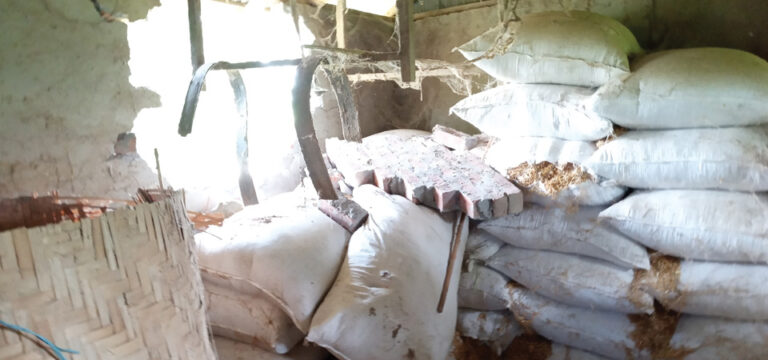
With the dearth of food and grazing area, wild elephants in Jhapa frequently enter the human settlements searching for food.
As the grazing area is reduced, they are forced to roam around the settlements and croplands, terrorising locals. For the past one week, a herd of wild elephants has been destroying houses and damaging crops in Kamal Rural Municipality, Shivasatakshi and Damak municipalities of the district.
Three wild elephants broke the wall of a rice mill at the house of Raghunath Poudel in Amaldangi, Kamal Rural Municipality-4, on Thursday night. A group of wild elephants have also eaten paddy brought to the rice mill for processing.
Similarly, a group of elephants has destroyed the paddy planted in 10 katthas of land of Ram Poudel in the area. When they found out that the elephants had entered the village, the locals tried to chase them away by burning tyres and blowing various types whistles. After the elephants did not run away, a police team deployed from the police post at Kerkha of the same village had tried to chase away the elephants by sounding a siren.
Assistant sub-inspector (ASI) of police Rajesh Shrestha and in charge of the police post said that the elephants did not escape despite their efforts.
According to Laxmi Poudel, a local, the elephants did not leave the area even after they burnt the tyres. The mother, along with its two calves, has caused much damage, locals said.
Likewise, 11 houses in the Falkland Lake area of Shivasatakshi Municipality-11 in the district were destroyed by wild elephants on Wednesday.
Lack of food and grazing area
In Jhapa, wild elephants have been causing a huge damage to property every year. Due to the lack of enough food in the forest areas, the wild elephants enter the settlements in search of food. They cause damage to the settlements and destroy houses and crops.
More than 41 people have been killed in the district in elephant attacks so far.
According to the statistics of the Forest Division Office, Jhapa, the office started recording the number of deaths due to elephant attacks since 1999.
Yuvraj Maskey, Divisional Forest Officer at the Division Forest Office in Jhapa, said that the practice of keeping record began only after the government of Nepal made a rule to compensate for wild animal victims. Even before this, it was estimated that more than 100 people had died in the district, he added.
A minimum area of 50 to 60 square kilometres is required for an elephant to graze. According to Bishnu Lal Ghimire, a former divisional officer of the Forest Division Office, Jhapa, the forest area is sufficient only for five to six elephants.
Similarly, an adult elephant needs 50 to 60 kgs of solid and liquid food a day.
There are 13 native wild elephants in the forest of Jhapa. Groups of wild elephants coming from India for grazing every year across the eastern border are adding to the damage, he was informed.
Source : TRN,





